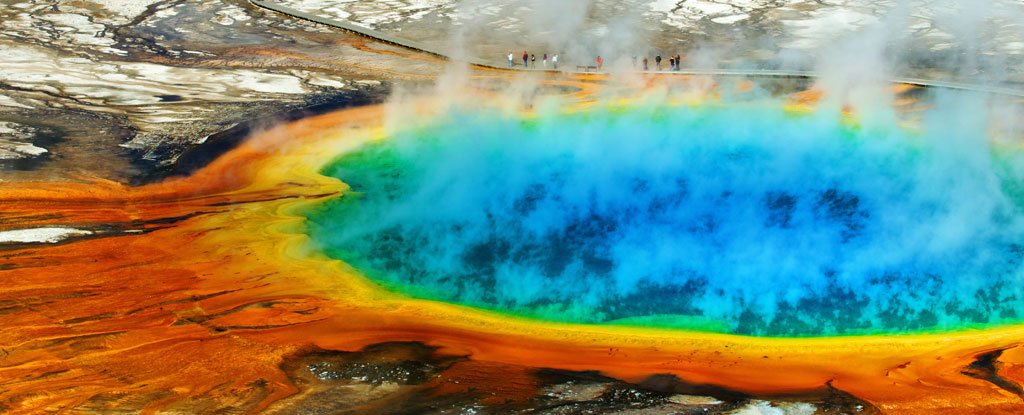
Scientists at NASA have developed a hugely ambitious
strategy to counter the looming threat of an apocalyptic supereruption from the
Yellowstone Caldera.
Yellowstone is one of about 20 known supervolcanoes around
the world, and an eruption from any of these could produce so much fiery magma
that the ensuing ash cloud might starve the Earth of sunlight in a choking,
years-long volcanic winter.
Against such a backdrop, NASA has been working on a plan to
counter this potentially far off but ultimately inevitable circumstance, which
could be graver than even the nightmare scenario of a planet-devastating
asteroid strike.
"I was a member of the NASA Advisory Council on
Planetary Defence which studied ways for NASA to defend the planet from
asteroids and comets," researcher Brian Wilcox from the space agency's Jet
Propulsion Laboratory told the BBC.
"I came to the conclusion during that study that the
supervolcano threat is substantially greater than the asteroid or comet
threat."
As recently as 2011, NASA was downplaying the immediate
risks of supereruptions, given the staggeringly long timeframes between which
they occur – roughly every 100,000 to 1 million years.
This, a NASA guide explains, means that large-scale
eruptions from supervolcanoes are "exceedingly rare and the odds that one
will occur in the lifetime of anybody reading this article are vanishingly
small".
The good news is those reassuring odds still hold, but
consider this: Yellowstone itself is thought to erupt once every 600,000 years
or so, and it's been about that long since its last supereruption.
While the chances of it exploding in any given year remain
low, it's clear we're edging ever closer to its thermal crisis point.
Which is why scientists at NASA compiled an as yet
unpublished report – largely unknown outside the space agency, but seen by the
BBC and other media outlets.
Their research concludes that the most logical way to
address the threat is to try to cool down the enormous magma chambers inside a
supervolcano.
Yellowstone is thought to leak about 60–70 percent of the
heat it generates into the atmosphere, released through the hot springs that
populate Yellowstone National Park.
The remaining, unvented heat is trapped inside the
supervolcano's magma chambers, and if enough heat builds up, it can ultimately
trigger an explosive supereruption.
Fortunately, NASA thinks Yellowstone would only need to
undergo a 35 percent heat reduction to avert such a catastrophe, and they've
got an idea for how you could pull off this epic cold shower.
By drilling as far down as 10 kilometres (6.2 miles) deep
inside Yellowstone, the space agency thinks it would be possible to pump
high-pressure water down into the supervolcano – circulating cool water in,
which would absorb scorching levels of heat before being pumped out again.
NASA estimates the piping hot water making the return trip
to the surface would have a temperature of about 350 degrees Celsius (662
degrees Fahrenheit) – and there's something pretty great we could do with all
that supervolcanic heat.
"Through drilling in this way, it could be used to
create a geothermal plant, which generates electric power at extremely
competitive prices of around $0.10/kWh," Wilcox explained to the BBC.
"[You would] get electricity which can power the
surrounding area for a period of potentially tens of thousands of years. And
the long-term benefit is that you prevent a future supervolcano eruption which
would devastate humanity."
So, the benefits are not only economic – they're potentially
planet-saving – but the estimated costs of building the project are almost as
insurmountable as a supervolcano.
NASA puts the price tag for the infrastructure at about
$3.46 billion, but as gargantuan as that fee is, it pales beside an even bigger
potential drawback with the plan – which is if something goes wrong.
"If you drill into the top of the magma chamber and try
and cool it from there, this would be very risky," Wilcox said.
"This could make the cap over the magma chamber more
brittle and prone to fracture. And you might trigger the release of harmful
volatile gases in the magma at the top of the chamber which would otherwise not
be released."
In the worst case scenario, a botched effort to drill inside
the supervolcano could hypothetically induce a supereruption, so humanity will
have to tread very carefully if it intends to pursue a plan like the one NASA's
come up with.
It's unclear quite where the strategy is up to, and whether
NASA will be officially releasing their report in the near future.
At the very least, Wilcox and his fellow researchers hope
that, by talking about their idea, it might encourage a serious scientific
discussion around ways to mitigate the impending threat of supervolcanoes.
Because one thing's for sure – these ancient, colossal time
bombs aren't going anywhere, and their clocks are ticking louder than ever.


Tiada ulasan:
Catat Ulasan